7 February Chamoli (Uttarakhand, India) Rock-Ice Avalanche Disaster: Model-Simulated Prevailing Meteorological Conditions
Abstract
:1. Introduction
2. Material and Methods
2.1. Event Description
2.2. Climatic and Physical Characteristics of the Study Region
2.3. WRF Model Simulation Details
| Parameter | Description |
|---|---|
| Initial and boundary data | ERA5 reanalysis |
| Temporal interval of boundary data | 6 h |
| Grid size | Domain 1: (146 × 151) × 50 |
| Domain 2: (226 × 231) × 50 | |
| Horizontal resolution | Domain 1: 9 km |
| Domain 2: 1.8 km | |
| Nesting | One way |
| Vertical levels | 50 |
| Time step | 15s |
| Land use land cover data | USGS data updated using AWiFS [60] |
| Topographic data | GMTED2010 [61] |
| Microphysics | Thompson scheme [67] |
| PBL scheme | YSU scheme [64] |
| Cumulus parameterization | Kain-Fritsch scheme [71] |
| Shortwave radiation | Dudhia scheme [68] |
| Longwave radiation | RRTM scheme [69] |
| Land surface model | Noah-MP land-surface model [66] |
| Surface-layer | Revised MM5 scheme [62] |
2.4. Data Analysis
3. Results and Discussion
3.1. Model Validation
3.2. Analysis of Meteorological Conditions near the Disaster Location
4. Conclusions
Author Contributions
Funding
Institutional Review Board Statement
Informed Consent Statement
Data Availability Statement
Acknowledgments
Conflicts of Interest
Abbreviations
| Abbreviation | Meaning |
| WRF | Weather Research and Forecasting |
| T2m | 2 Meter Air Temperature (K) |
| Ts | Surface/Skin Temperature (K) |
| ERA5-Land | ECMWF Reanalysis v3 Land |
| GPM | Global Precipitation Measurement |
| IMERG | Integrated Multi-satellitE Retrievals for GPM |
| CFSR | Climate Forecast System Reanalysis |
| ECMWF | European Centre for Medium-Range Weather Forecasts |
| IMD | India Meteorological Department |
| JJAS | June-July-August-September |
| masl | Meters Above Sea Level |
| hPa | Hectopascal |
| USGS | United States Geological Survey |
| LULC | Land Use and Land Cover |
| ISRO | Indian Space Research Organisation |
| AWiFS | Advanced Wide Field Sensor |
| GMTED2010 | Global Multi-resolution Terrain Elevation Data 2010 |
| YSU | Yonsei University |
| PBL | Planetary Boundary Layer |
| RRMT | Rapid Radiative Transfer Model |
| MAB | Mean Absolute Bias |
| RMSE | Root Mean Square Error |
| CH | Heat Transfer Coefficient |
| CD | Drag Coefficient |
| SW | Shortwave |
| OLR | Outgoing Longwave Radiation (W/m2) |
| GLW | Ground Longwave |
| U10 | 10 m Wind Speed (m/s) |
| u* | Friction Velocity (m/s) |
| SHF | Sensible Heat Flux (W/m2) |
| LHF | Latent Heat Flux (W/m2) |
| q2m | Specific Humidity at 2 m |
References
- Arora, M.; Singh, P.; Goel, N.K.; Singh, R.D. Spatial Distribution and Seasonal Variability of Rainfall in a Mountainous Basin in the Himalayan Region. Water Resour. Manag. 2006, 20, 489–508. [Google Scholar] [CrossRef]
- Devrani, R.; Singh, V.; Mudd, S.M.; Sinclair, H.D. Prediction of flash flood hazard impact from Himalayan river profiles. Geophys. Res. Lett. 2015, 42, 5888–5894. [Google Scholar] [CrossRef]
- Asthana, A.K.L.; Sah, M.P. Landslides and cloudbursts in the Mandakini Basin of Garhwal Himalaya. Himal. Geol. 2007, 28, 59–67. [Google Scholar]
- Islam, M.A.; Chattoraj, S.L.; Ray, P.K. Ukhimath landslide 2012 at Uttarakhand, India: Causes and consequences. Int. J. Geomat. Geosci. 2014, 4, 544–557. [Google Scholar]
- Dikshit, A.; Sarkar, R.; Pradhan, B.; Segoni, S.; Alamri, A.M. Rainfall Induced Landslide Studies in Indian Himalayan Region: A Critical Review. Appl. Sci. 2020, 10, 2466. [Google Scholar] [CrossRef] [Green Version]
- Das, S.; Ashrit, R.; Moncrieff, M.W. Simulation of a Himalayan cloudburst event. J. Earth Syst. Sci. 2006, 115, 299–313. [Google Scholar] [CrossRef] [Green Version]
- Dimri, A.P.; Chevuturi, A.; Niyogi, D.; Thayyen, R.J.; Ray, K.; Tripathi, S.N.; Pandey, A.K.; Mohanty, U.C. Cloudbursts in Indian Himalayas: A review. Earth-Sci. Rev. 2017, 168, 1–23. [Google Scholar] [CrossRef]
- Kumar, P.; Shukla, B.P.; Sharma, S.; Kishtawal, C.M.; Pal, P.K. A high-resolution simulation of catastrophic rainfall over Uttarakhand, India. Nat. Hazards 2016, 80, 1119–1134. [Google Scholar] [CrossRef]
- Dobriyal, M.; Bijalwan, A. Forest fire in western Himalayas of India: A review. N. Y. Sci. J. 2017, 10, 39–46. [Google Scholar]
- Dubey, S.; Goyal, M.K. Glacial Lake Outburst Flood Hazard, Downstream Impact, and Risk Over the Indian Himalayas. Water Resour. Res. 2020, 56, e2019WR026533. [Google Scholar] [CrossRef]
- Liu, J.; Wu, Y.; Gao, X. Increase in occurrence of large glacier-related landslides in the high mountains of Asia. Sci. Rep. 2021, 11, 1635. [Google Scholar] [CrossRef]
- Goswami, B.N.; Venugopal, V.; Sengupta, D.; Madhusoodanan, M.S.; Xavier, P.K. Increasing Trend of Extreme Rain Events Over India in a Warming Environment. Science 2006, 314, 1442–1445. [Google Scholar] [CrossRef] [PubMed] [Green Version]
- López-Moreno, J.I.; Pomeroy, J.W.; Morán-Tejeda, E.; Revuelto, J.; Navarro-Serrano, F.M.; Vidaller, I.; Alonso-González, E. Changes in the frequency of global high mountain rain-on-snow events due to climate warming. Environ. Res. Lett. 2021, 16, 094021. [Google Scholar] [CrossRef]
- IPCC. Climate Change 2021: The Physical Science Basis. Contribution of Working Group I to the Sixth Assessment Report of the Intergovernmental Panel on Climate Change; Masson-Delmotte, V., Zhai, P., Pirani, A., Connors, S.L., Péan, C., Berger, S., Caud, N., Chen, Y., Goldfarb, L., Gomis, M.I., et al., Eds.; Cambridge University Press: Cambridge, UK, 2021; in press. [Google Scholar]
- Richardson, S.D.; Reynolds, J.M. An overview of glacial hazards in the Himalayas. Quat. Int. 2000, 65–66, 31–47. [Google Scholar] [CrossRef]
- Nie, Y.; Liu, Q.; Wang, J.; Zhang, Y.; Sheng, Y.; Liu, S. An inventory of historical glacial lake outburst floods in the Himalayas based on remote sensing observations and geomorphological analysis. Geomorphology 2018, 308, 91–106. [Google Scholar] [CrossRef]
- Shugar, D.H.; Burr, A.; Haritashya, U.K.; Kargel, J.S.; Watson, C.S.; Kennedy, M.C.; Bevington, A.R.; Betts, R.A.; Harrison, S.; Strattman, K. Rapid worldwide growth of glacial lakes since 1990. Nat. Clim. Chang. 2020, 10, 939–945. [Google Scholar] [CrossRef]
- King, O.; Bhattacharya, A.; Bhambri, R.; Bolch, T. Glacial lakes exacerbate Himalayan glacier mass loss. Sci. Rep. 2019, 9, 18145. [Google Scholar] [CrossRef] [Green Version]
- Rinzin, S.; Zhang, G.; Wangchuk, S. Glacial Lake Area Change and Potential Outburst Flood Hazard Assessment in the Bhutan Himalaya. Front. Earth Sci. 2021, 9, 1136. [Google Scholar] [CrossRef]
- Chevuturi, A.; Dimri, A.P.; Das, S.; Kumar, A.; Niyogi, D. Numerical simulation of an intense precipitation event over Rudraprayag in the central Himalayas during 13–14 September 2012. J. Earth Syst. Sci. 2015, 124, 1545–1561. [Google Scholar] [CrossRef]
- Singh, R.; Siingh, D.; Gokani, S.A.; Sreeush, M.G.; Buchunde, P.S.; Maurya, A.K.; Singh, R.P.; Singh, A.K. Brief Communication: Climatic, meteorological and topographical causes of the 16–17 June 2013 Kedarnath (India) natural disaster event. Nat. Hazards Earth Syst. Sci. 2015, 15, 1597–1601. [Google Scholar] [CrossRef] [Green Version]
- Sati, S.P.; Sundriyal, Y.P.; Rana, N.; Dangwal, S. Recent landslides in Uttarakhand: Nature’s fury or human folly. Curr. Sci. 2011, 100, 1617–1620. [Google Scholar]
- Naithani, A.K.; Rawat, G.S.; Nawani, P.C. Investigation of landslide events on 12th July 2007 due to cloudburst in Chamoli district, Uttarakhand, India. Int. J. Earth Sci. Eng. 2011, 4, 777–786. [Google Scholar]
- Bhan, S.C.; Devrani, A.K.; Sinha, V. An analysis of monthly rainfall and the meteorological conditions associated with cloudburst over the dry region of Leh (Ladakh), India. Mausam 2015, 66, 107–122. [Google Scholar] [CrossRef]
- Allen, S.K.; Rastner, P.; Arora, M.; Huggel, C.; Stoffel, M. Lake outburst and debris flow disaster at Kedarnath, June 2013: Hydrometeorological triggering and topographic predisposition. Landslides 2016, 13, 1479–1491. [Google Scholar] [CrossRef]
- Raymond, C.; Horton, R.M.; Zscheischler, J.; Martius, O.; AghaKouchak, A.; Balch, J.; Bowen, S.G.; Camargo, S.J.; Hess, J.; Kornhuber, K.; et al. Understanding and managing connected extreme events. Nat. Clim. Chang. 2020, 10, 611–621. [Google Scholar] [CrossRef]
- Saha, S.; Moorthi, S.; Pan, H.-L.; Wu, X.; Wang, J.; Nadiga, S.; Tripp, P.; Kistler, R.; Woollen, J.; Behringer, D.; et al. The NCEP Climate Forecast System Reanalysis. Bull. Am. Meteorol. Soc. 2010, 91, 1015–1058. [Google Scholar] [CrossRef]
- Copernicus Climate Change Service (C3S). ERA5: Fifth generation of ECMWF atmospheric reanalyses of the global climate. Copernic. Clim. Chang. Serv. Clim. Data Store 2017, 15, 2020. [Google Scholar]
- Pattnayak, K.C.; Panda, S.K.; Saraswat, V.; Dash, S.K. How good is regional climate model version 4 in simulating the monsoon onset over Kerala? Int. J. Climatol. 2019, 39, 2197–2208. [Google Scholar] [CrossRef] [Green Version]
- Pattnayak, K.C.; Panda, S.K.; Saraswat, V.; Dash, S.K. Assessment of two versions of regional climate model in simulating the Indian Summer Monsoon over South Asia CORDEX domain. Clim. Dyn. 2018, 50, 3049–3061. [Google Scholar] [CrossRef] [Green Version]
- Skamarock, W.C.; Klemp, J.B.; Dudhia, J.; Gill, D.O.; Liu, Z.; Berner, J.; Wang, W.; Powers, J.G.; Duda, M.G.; Barker, D.M. A description of the advanced research WRF model version 4. Natl. Cent. Atmos. Res. Boulder CO USA 2019, 145, 145. [Google Scholar]
- Mohan, M.; Sati, A.P. WRF model performance analysis for a suite of simulation design. Atmos. Res. 2016, 169, 280–291. [Google Scholar] [CrossRef]
- Sati, A.P.; Mohan, M. The impact of urbanization during half a century on surface meteorology based on WRF model simulations over National Capital Region, India. Theor. Appl. Climatol. 2018, 134, 309–323. [Google Scholar] [CrossRef]
- Kumar, A.; Jiménez, R.; Belalcázar, L.C.; Rojas, N.Y. Application of WRF-Chem Model to Simulate PM10 Concentration over Bogota. Aerosol Air Qual. Res. 2016, 16, 1206–1221. [Google Scholar] [CrossRef] [Green Version]
- Gochis, D.J.; Barlage, M.; Dugger, A.; FitzGerald, K.; Karsten, L.; McAllister, M.; McCreight, J.; Mills, J.; RafieeiNasab, A.; Read, L. The WRF-Hydro Modeling System Technical Description, Version 5.0. 2020. Available online: https://ral.ucar.edu/projects/wrf_hydro/technical-description-user-guide (accessed on 1 January 2022).
- Sun, M.; Li, Z.; Yao, C.; Liu, Z.; Wang, J.; Hou, A.; Zhang, K.; Huo, W.; Liu, M. Evaluation of Flood Prediction Capability of the WRF-Hydro Model Based on Multiple Forcing Scenarios. Water 2020, 12, 874. [Google Scholar] [CrossRef] [Green Version]
- Coen, J.L.; Cameron, M.; Michalakes, J.; Patton, E.G.; Riggan, P.J.; Yedinak, K.M. WRF-Fire: Coupled Weather–Wildland Fire Modeling with the Weather Research and Forecasting Model. J. Appl. Meteorol. Climatol. 2013, 52, 16–38. [Google Scholar] [CrossRef]
- Tallapragada, V.; Bernardet, L.; Biswas, M.K.; Ginis, I.; Kwon, Y.; Liu, Q.; Marchok, T.; Sheinin, D.; Thomas, B.; Tong, M.; et al. Hurricane Weather Research and Forecasting (HWRF) Model: 2015 Scientific Documentation. Dev. Testbed Cent. 2015, 113, 99. [Google Scholar]
- Zhang, J.A.; Kalina, E.A.; Biswas, M.K.; Rogers, R.F.; Zhu, P.; Marks, F.D. A Review and Evaluation of Planetary Boundary Layer Parameterizations in Hurricane Weather Research and Forecasting Model Using Idealized Simulations and Observations. Atmosphere 2020, 11, 1091. [Google Scholar] [CrossRef]
- Krishnamurti, T.N.; Kumar, V.; Simon, A.; Thomas, A.; Bhardwaj, A.; Das, S.; Senroy, S.; Roy Bhowmik, S.K. March of buoyancy elements during extreme rainfall over India. Clim. Dyn. 2017, 48, 1931–1951. [Google Scholar] [CrossRef]
- Kotal, S.D.; Roy, S.S.; Bhowmik, S.K.R. Catastrophic heavy rainfall episode over Uttarakhand during 16–18 June 2013–observational aspects. Curr. Sci. 2014, 234–245. [Google Scholar]
- Chaudhuri, C.; Tripathi, S.; Srivastava, R.; Misra, A. Observation- and numerical-analysis-based dynamics of the Uttarkashi cloudburst. Ann. Geophys. 2015, 33, 671–686. [Google Scholar] [CrossRef] [Green Version]
- Zhang, Y.; Hemperly, J.; Meskhidze, N.; Skamarock, W.C. The Global Weather Research and Forecasting (GWRF) Model: Model Evaluation, Sensitivity Study, and Future Year Simulation. Atmos. Clim. Sci. 2012, 2, 231–253. [Google Scholar] [CrossRef] [Green Version]
- Hsiao, L.-F.; Chen, D.-S.; Kuo, Y.-H.; Guo, Y.-R.; Yeh, T.-C.; Hong, J.-S.; Fong, C.-T.; Lee, C.-S. Application of WRF 3DVAR to Operational Typhoon Prediction in Taiwan: Impact of Outer Loop and Partial Cycling Approaches. Weather Forecast. 2012, 27, 1249–1263. [Google Scholar] [CrossRef]
- Powers, J.G.; Klemp, J.B.; Skamarock, W.C.; Davis, C.A.; Dudhia, J.; Gill, D.O.; Coen, J.L.; Gochis, D.J.; Ahmadov, R.; Peckham, S.E.; et al. The Weather Research and Forecasting Model: Overview, System Efforts, and Future Directions. Bull. Am. Meteorol. Soc. 2017, 98, 1717–1737. [Google Scholar] [CrossRef]
- Benjamin, S.G.; Weygandt, S.S.; Brown, J.M.; Hu, M.; Alexander, C.R.; Smirnova, T.G.; Olson, J.B.; James, E.P.; Dowell, D.C.; Grell, G.A.; et al. A North American Hourly Assimilation and Model Forecast Cycle: The Rapid Refresh. Mon. Weather Rev. 2016, 144, 1669–1694. [Google Scholar] [CrossRef]
- Zhuo, L.; Dai, Q.; Han, D.; Chen, N.; Zhao, B. Assessment of simulated soil moisture from WRF Noah, Noah-MP, and CLM land surface schemes for landslide hazard application. Hydrol. Earth Syst. Sci. 2019, 23, 4199–4218. [Google Scholar] [CrossRef] [Green Version]
- Nuryanto, D.E.; Fajariana, Y.; Pradana, R.P.; Anggraeni, R.; Badri, I.U.; Sopaheluwakan, A. Modeling of Heavy Rainfall Triggering Landslide Using WRF Model. Agromet 2020, 34, 55–65. [Google Scholar] [CrossRef]
- Nuryanto, D.E.; Satyaningsih, R.; Nuraini, T.A.; Fajariana, Y.; Anggraeni, R.; Sopaheluwakan, A.; Yuliyanti, M.S. Prediction of soil moisture and rainfall induced landslides: A comparison of several PBL parameters in the WRF model. IOP Conf. Ser. Earth Environ. Sci. 2021, 893, 12025. [Google Scholar] [CrossRef]
- Susandi, A.; Tamamadin, M.; Pratama, A.; Faisal, I.; Wijaya, A.R.; Pratama, A.F.; Pandini, O.P.; Widiawan, D.A. Development of Hydro-Meteorological Hazard Early Warning System in Indonesia. J. Eng. Technol. Sci. 2018, 50, 461–468. [Google Scholar] [CrossRef]
- Shugar, D.H.; Jacquemart, M.; Shean, D.; Bhushan, S.; Upadhyay, K.; Sattar, A.; Schwanghart, W.; McBride, S.; de Vries, M.V.W.; Mergili, M.; et al. A massive rock and ice avalanche caused the 2021 disaster at Chamoli, Indian Himalaya. Science 2021, 373, 300–306. [Google Scholar] [CrossRef]
- Thayyen, R.J.; Mishra, P.K.; Jain, S.K.; Wani, J.M.; Singh, H.; Singh, M.K.; Yadav, B. Hanging glacier avalanche (Raunthigad—Rishiganga) and Debris flow disaster of 7th February 2021, Uttarakhand, India, A Preliminary assessment. Nat. Hazards 2022, in press. [Google Scholar] [CrossRef]
- Pandey, P.; Chauhan, P.; Bhatt, C.M.; Thakur, P.K.; Kannaujia, S.; Dhote, P.R.; Roy, A.; Kumar, S.; Chopra, S.; Bhardwaj, A.; et al. Cause and Process Mechanism of Rockslide Triggered Flood Event in Rishiganga and Dhauliganga River Valleys, Chamoli, Uttarakhand, India Using Satellite Remote Sensing and in situ Observations. J. Indian Soc. Remote Sens. 2021, 49, 1011–1024. [Google Scholar] [CrossRef]
- Mao, W.; Wu, L.; Singh, R.P.; Qi, Y.; Xie, B.; Liu, Y.; Ding, Y.; Zhou, Z.; Li, J. Progressive destabilization and triggering mechanism analysis using multiple data for Chamoli rockslide of 7 February 2021. Geomat. Nat. Hazards Risk 2022, 13, 35–53. [Google Scholar] [CrossRef]
- Arun, B.S.; Steiner, J.; Nepal, S.; Maharjan, S.B.; Jackson, M.; Rasul, G.; Bajracharya, B. Understanding the Chamoli Flood: Cause, Process, Impacts, and Context of Rapid Infrastructure Development. 2021. Available online: https://www.icimod.org/article/understanding-the-chamoli-flood-cause-process-impacts-and-context-of-rapid-infrastructure-development (accessed on 1 January 2022).
- Valdiya, K.S. Emergence and evolution of Himalaya: Reconstructing history in the light of recent studies. Prog. Phys. Geogr. Earth Environ. 2002, 26, 360–399. [Google Scholar] [CrossRef]
- Martha, T.R.; Roy, P.; Jain, N.; Vinod Kumar, K.; Reddy, P.S.; Nalini, J.; Sharma, S.V.; Shukla, A.K.; Durga Rao, K.H.; Narender, B.; et al. Rock avalanche induced flash flood on 07 February 2021 in Uttarakhand, India—A photogeological reconstruction of the event. Landslides 2021, 18, 2881–2893. [Google Scholar] [CrossRef]
- Pandey, V.K.; Kumar, R.; Singh, R.; Kumar, R.; Rai, S.C.; Singh, R.P.; Tripathi, A.K.; Soni, V.K.; Ali, S.N.; Tamang, D.; et al. Catastrophic ice-debris flow in the Rishiganga River, Chamoli, Uttarakhand (India). Geomat. Nat. Hazards Risk 2022, 13, 289–309. [Google Scholar] [CrossRef]
- Jiang, R.; Zhang, L.; Peng, D.; He, X.; He, J. The Landslide Hazard Chain in the Tapovan of the Himalayas on 7 February 2021. Geophys. Res. Lett. 2021, 48, e2021GL093723. [Google Scholar] [CrossRef]
- Biswadip, G. IRS-P6 AWiFS Derived Gridded Land Use/Land Cover Data Compatible to Mesoscale Models (MM5 and WRF) over Indian Region; NRSC Technical Document No. NRSC-ECSA-ACSG-OCT-2014-TR-651; NRSC: Hyderabad, India, 2014. [Google Scholar]
- Danielson, J.J.; Gesch, D.B. Global Multi-Resolution Terrain Elevation Data 2010 (GMTED2010); US Department of the Interior, US Geological Survey: Washington, DC, USA, 2011.
- Jiménez, P.A.; Dudhia, J.; González-Rouco, J.F.; Navarro, J.; Montávez, J.P.; García-Bustamante, E. A Revised Scheme for the WRF Surface Layer Formulation. Mon. Weather Rev. 2012, 140, 898–918. [Google Scholar] [CrossRef] [Green Version]
- Srivastava, P.; Sharan, M.; Kumar, M. A note on surface layer parameterizations in the weather research and forecast model. Dyn. Atmos. Ocean. 2021, 96, 101259. [Google Scholar] [CrossRef]
- Hong, S.-Y.; Noh, Y.; Dudhia, J. A New Vertical Diffusion Package with an Explicit Treatment of Entrainment Processes. Mon. Weather Rev. 2006, 134, 2318–2341. [Google Scholar] [CrossRef] [Green Version]
- Jiménez, P.A.; Dudhia, J. Improving the Representation of Resolved and Unresolved Topographic Effects on Surface Wind in the WRF Model. J. Appl. Meteorol. Climatol. 2012, 51, 300–316. [Google Scholar] [CrossRef] [Green Version]
- Niu, G.-Y.; Yang, Z.-L.; Mitchell, K.E.; Chen, F.; Ek, M.B.; Barlage, M.; Kumar, A.; Manning, K.; Niyogi, D.; Rosero, E.; et al. The community Noah land surface model with multiparameterization options (Noah-MP): 1. Model description and evaluation with local-scale measurements. J. Geophys. Res. 2011, 116, D12109. [Google Scholar] [CrossRef] [Green Version]
- Thompson, G.; Field, P.R.; Rasmussen, R.M.; Hall, W.D. Explicit Forecasts of Winter Precipitation Using an Improved Bulk Microphysics Scheme. Part II: Implementation of a New Snow Parameterization. Mon. Weather Rev. 2008, 136, 5095–5115. [Google Scholar] [CrossRef]
- Dudhia, J. Numerical Study of Convection Observed during the Winter Monsoon Experiment Using a Mesoscale Two-Dimensional Model. J. Atmos. Sci. 1989, 46, 3077–3107. [Google Scholar] [CrossRef]
- Mlawer, E.J.; Taubman, S.J.; Brown, P.D.; Iacono, M.J.; Clough, S.A. Radiative transfer for inhomogeneous atmospheres: RRTM, a validated correlated-k model for the longwave. J. Geophys. Res. Atmos. 1997, 102, 16663–16682. [Google Scholar] [CrossRef] [Green Version]
- Norris, J.; Carvalho, L.M.V.; Jones, C.; Cannon, F.; Bookhagen, B.; Palazzi, E.; Tahir, A.A. The spatiotemporal variability of precipitation over the Himalaya: Evaluation of one-year WRF model simulation. Clim. Dyn. 2017, 49, 2179–2204. [Google Scholar] [CrossRef]
- Kain, J.S.; Fritsch, J.M. Convective Parameterization for Mesoscale Models: The Kain-Fritsch Scheme. In The Representation of Cumulus Convection in Numerical Models; American Meteorological Society: Boston, MA, USA, 1993; pp. 165–170. [Google Scholar]
- Huffman, G.J.; Stocker, E.F.; Bolvin, D.T.; Nelkin, E.J.; Tan, J. GPM IMERG Final Precipitation L3 Half Hourly 0.1 degree x 0.1 degree V06. 2019. Available online: https://disc.gsfc.nasa.gov/datasets/GPM_3IMERGHH_06/summary (accessed on 1 January 2022).
- Chen, Y.; Sharma, S.; Zhou, X.; Yang, K.; Li, X.; Niu, X.; Hu, X.; Khadka, N. Spatial performance of multiple reanalysis precipitation datasets on the southern slope of central Himalaya. Atmos. Res. 2021, 250, 105365. [Google Scholar] [CrossRef]
- Azam, M.F.; Srivastava, S. Mass balance and runoff modelling of partially debris-covered Dokriani Glacier in monsoon-dominated Himalaya using ERA5 data since 1979. J. Hydrol. 2020, 590, 125432. [Google Scholar] [CrossRef]
- Mitra, A.K.; Kaushik, N.; Kumar Singh, A.; Parihar, S.; Bhan, S.C. Evaluation of INSAT-3D satellite derived precipitation estimates for heavy rainfall events and its validation with gridded GPM (IMERG) rainfall dataset over the Indian region. Remote Sens. Appl. Soc. Environ. 2018, 9, 91–99. [Google Scholar] [CrossRef]
- Zhou, Y.; Li, X.; Zheng, D.; Li, Z.; An, B.; Wang, Y.; Jiang, D.; Su, J.; Cao, B. The joint driving effects of climate and weather changes caused the Chamoli glacier-rock avalanche in the high altitudes of the India Himalaya. Sci. China Earth Sci. 2021, 64, 1909–1921. [Google Scholar] [CrossRef]
- McColl, S.T.; Davies, T.R. Evidence for a rock-avalanche origin for ‘The Hillocks’ “moraine”, Otago, New Zealand. Geomorphology 2011, 127, 216–224. [Google Scholar] [CrossRef]
- Ballantyne, C.K.; Sandeman, G.F.; Stone, J.O.; Wilson, P. Rock-slope failure following Late Pleistocene deglaciation on tectonically stable mountainous terrain. Quat. Sci. Rev. 2014, 86, 144–157. [Google Scholar] [CrossRef] [Green Version]
- Grämiger, L.M.; Moore, J.R.; Gischig, V.S.; Loew, S. Thermomechanical Stresses Drive Damage of Alpine Valley Rock Walls During Repeat Glacial Cycles. J. Geophys. Res. Earth Surf. 2018, 123, 2620–2646. [Google Scholar] [CrossRef]
- Fan, X.; Yunus, A.P.; Yang, Y.-H.; Srikrishnan, S.S.; Zou, C.; Dai, L.; Dou, X.; Narayana, A.C.; Avtar, R.; Xu, Q.; et al. Imminent Threat of Rock-Ice Avalanches in High Mountain Asia. SSRN Electron. J. 2021, in press. [Google Scholar] [CrossRef]
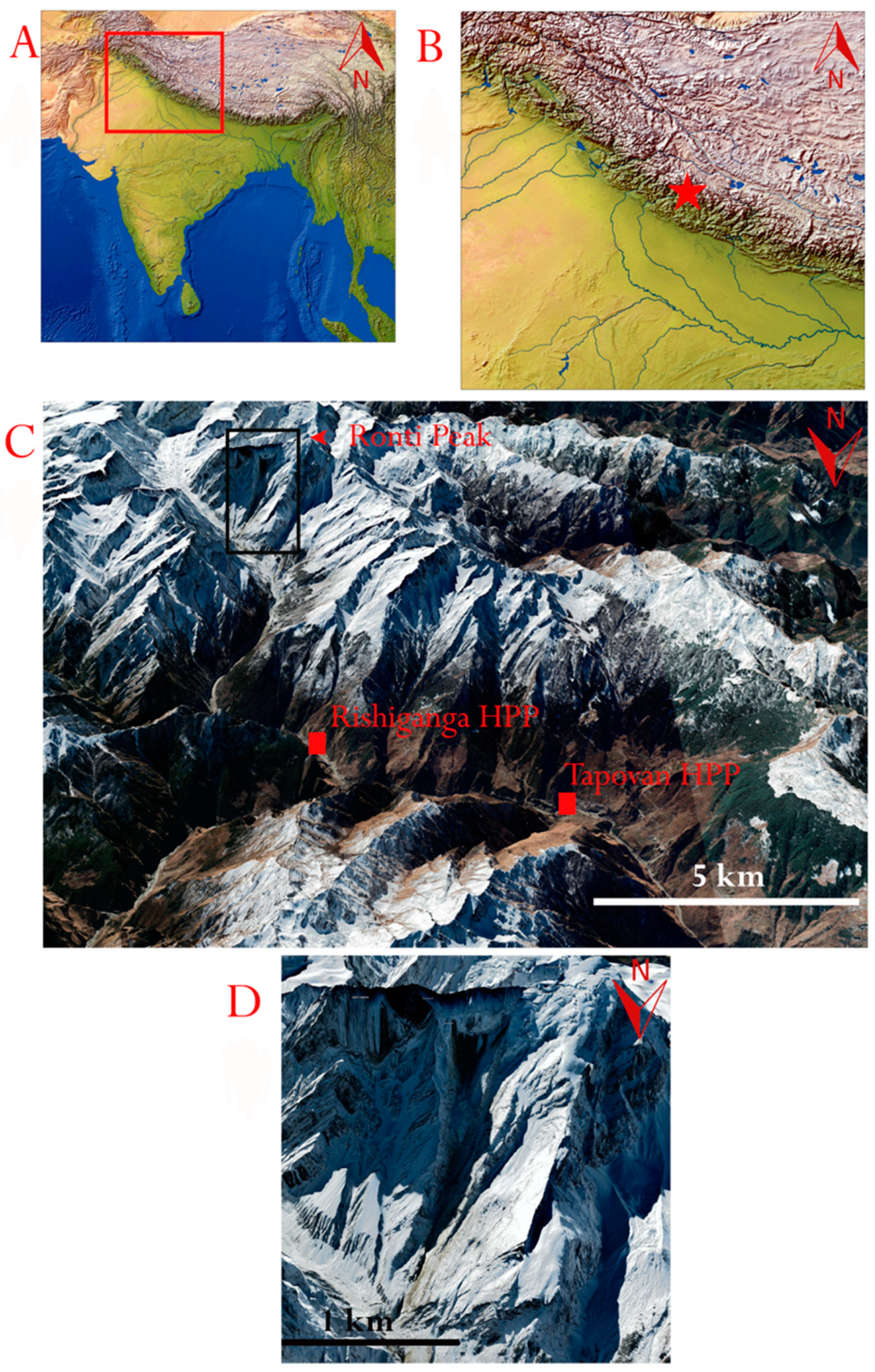

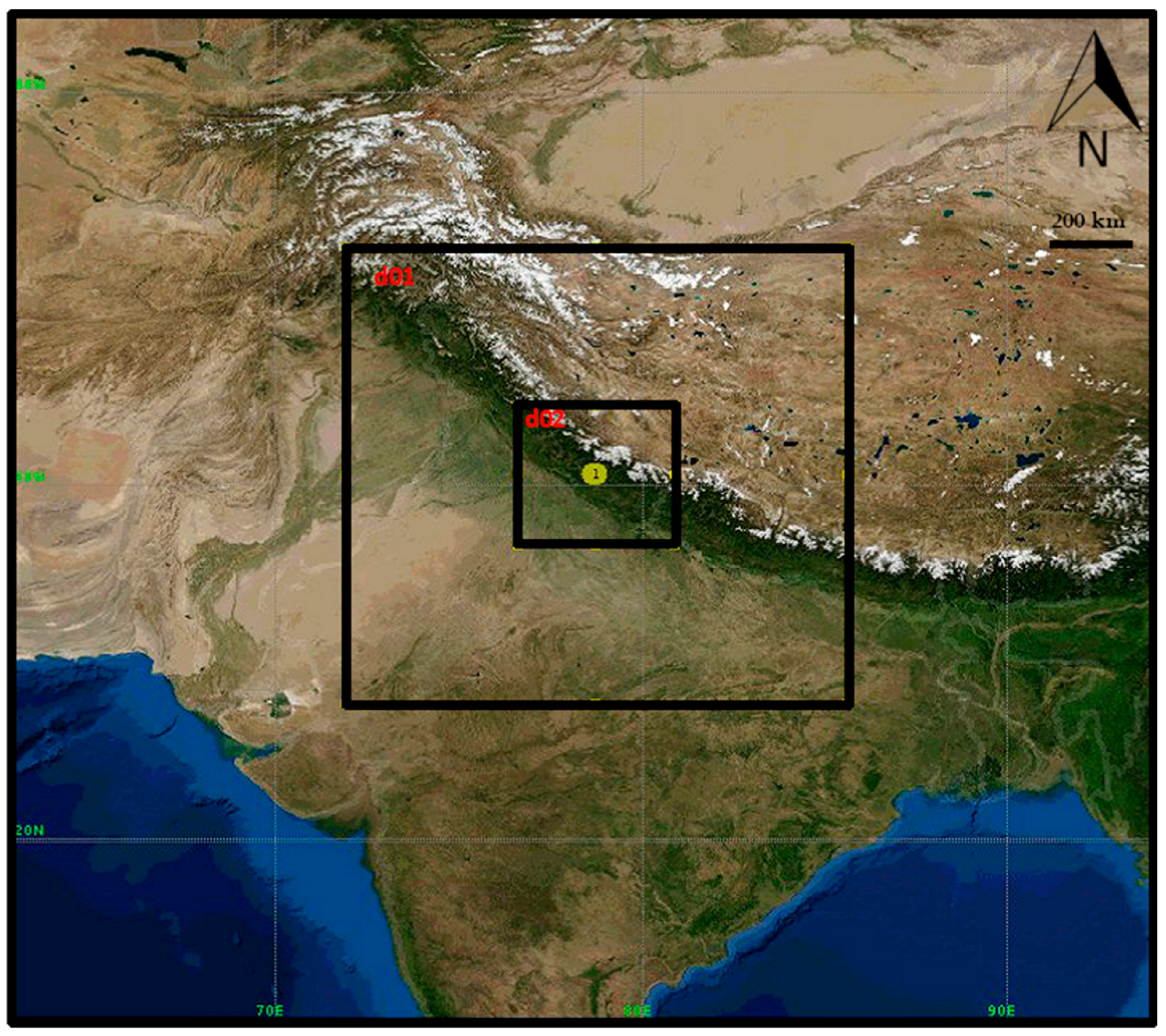
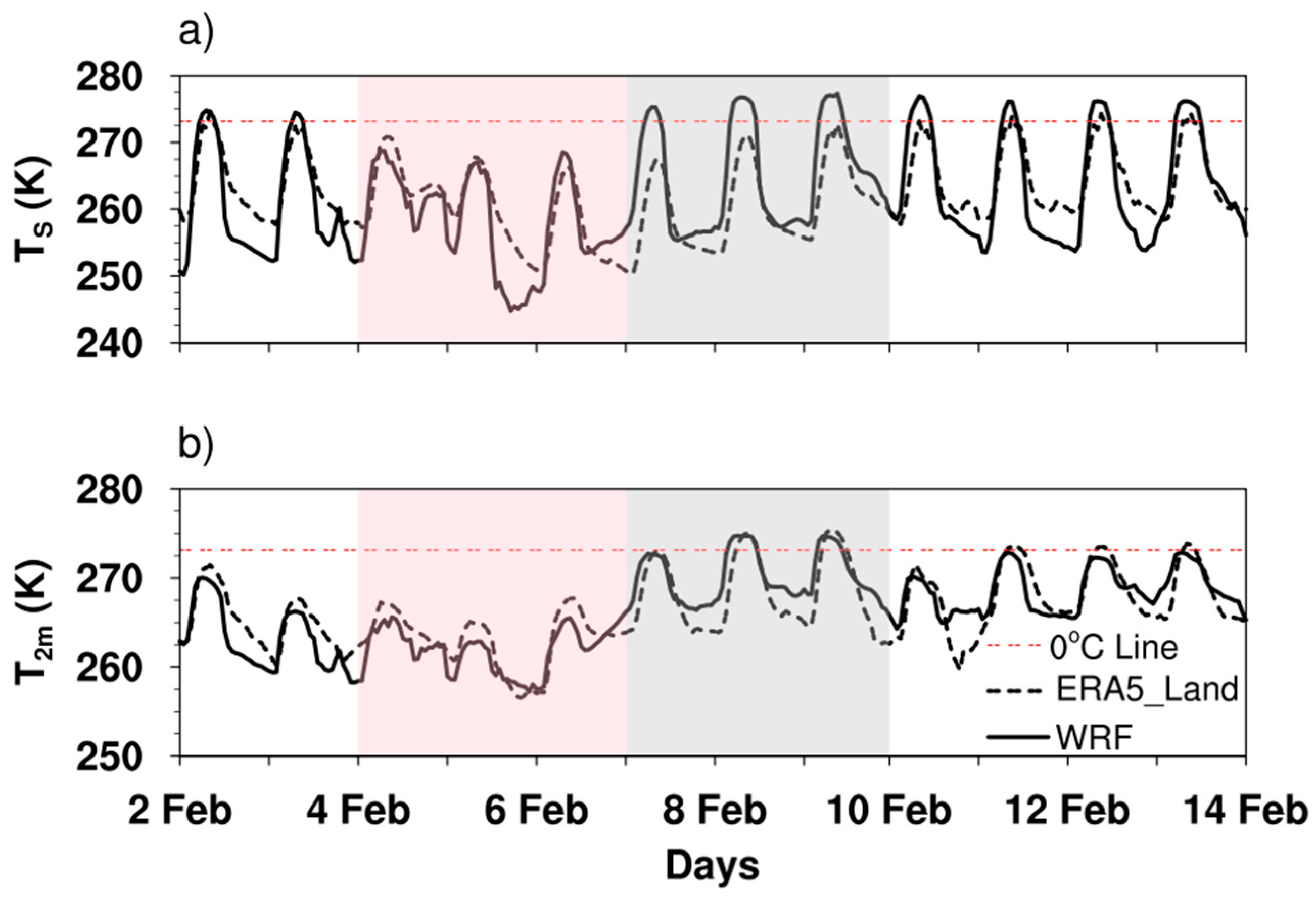
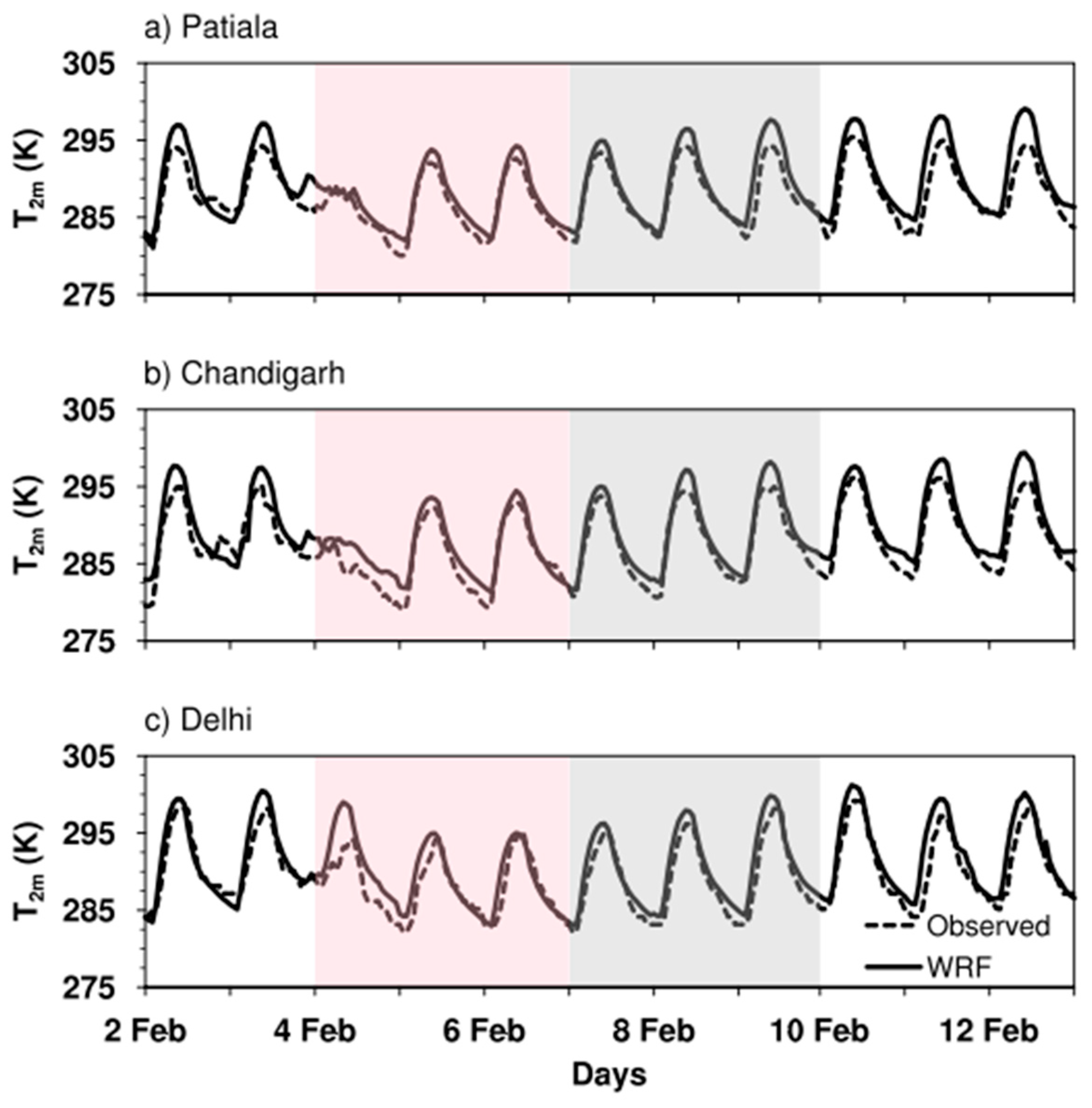
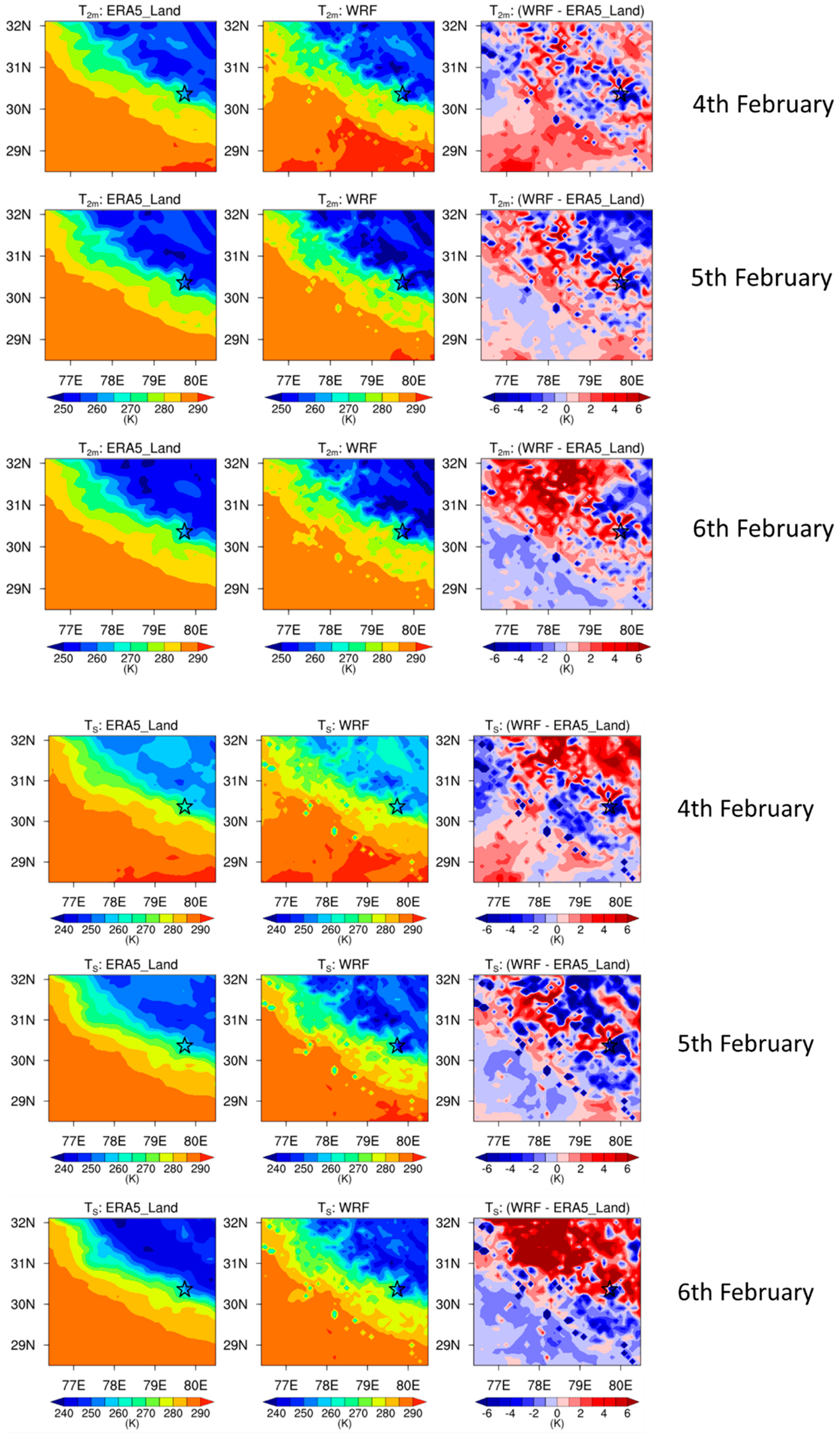
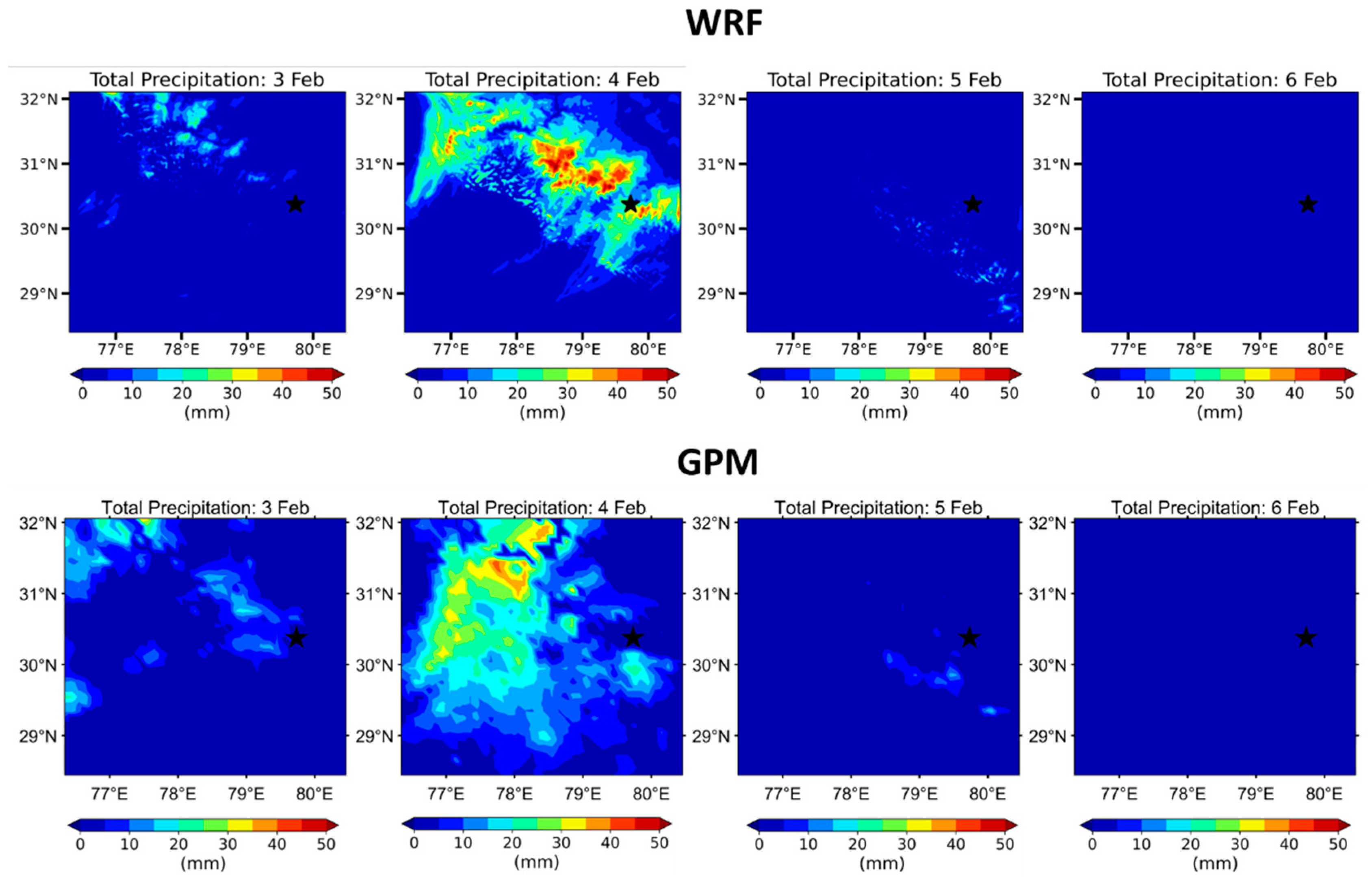
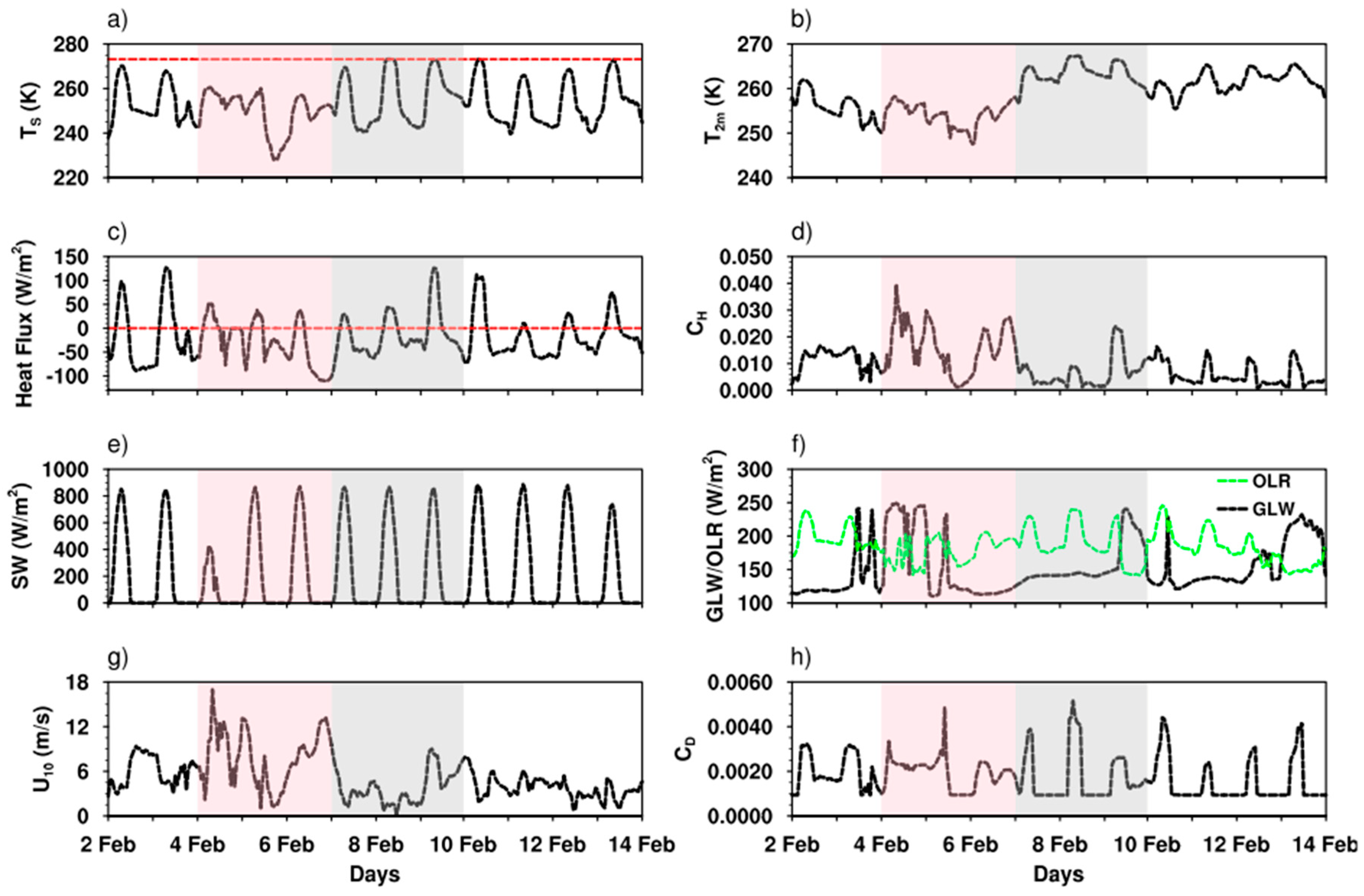
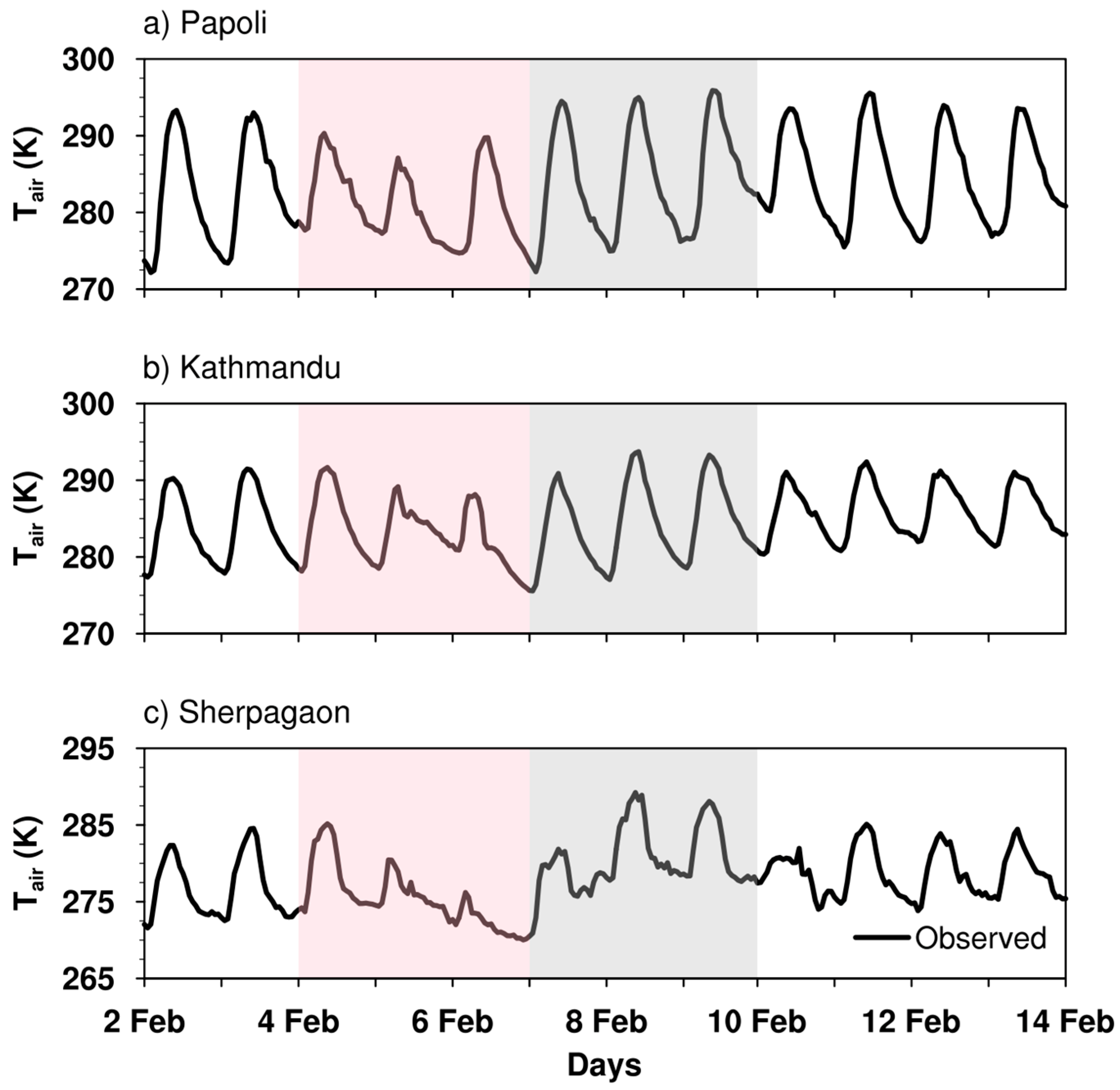
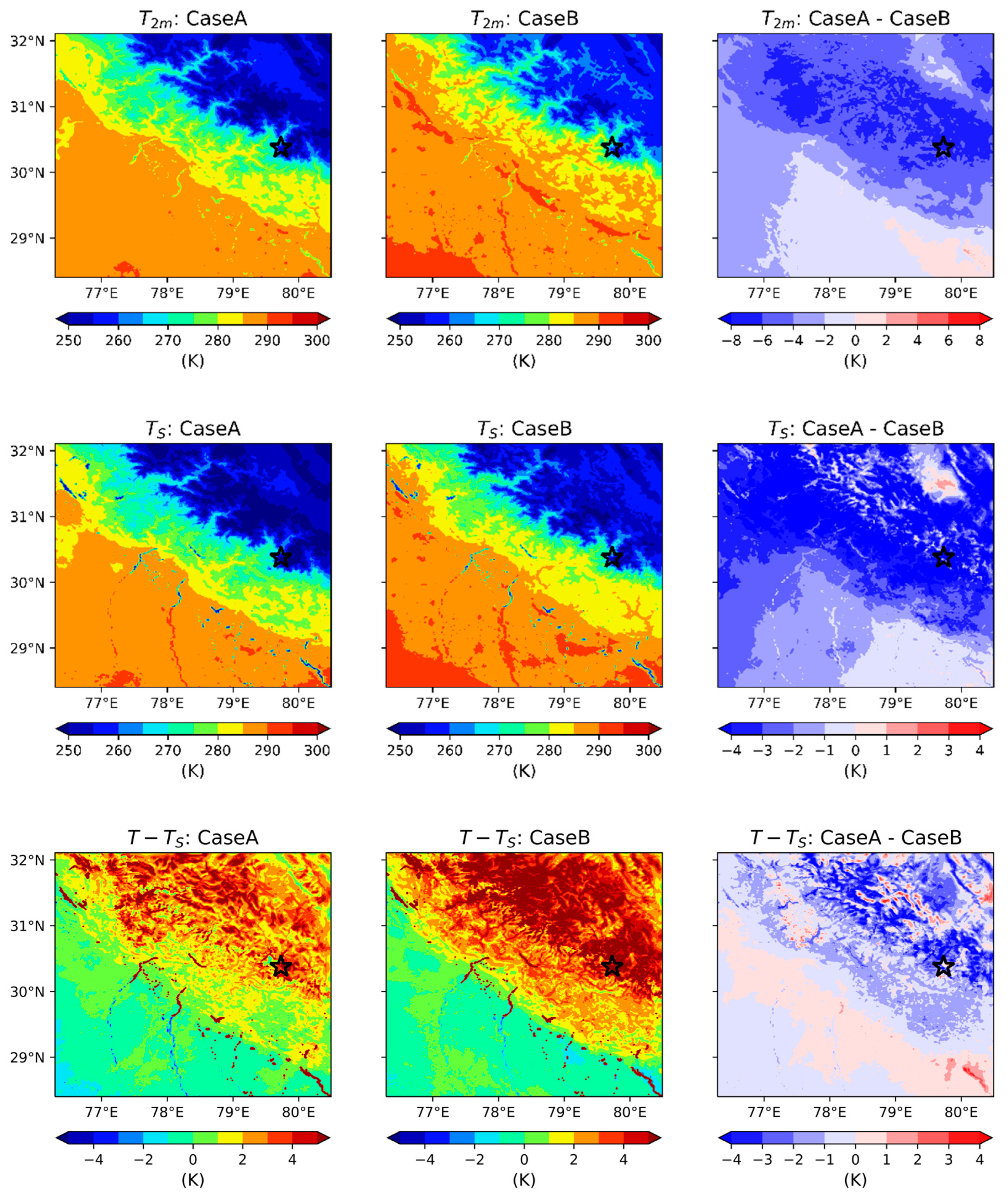

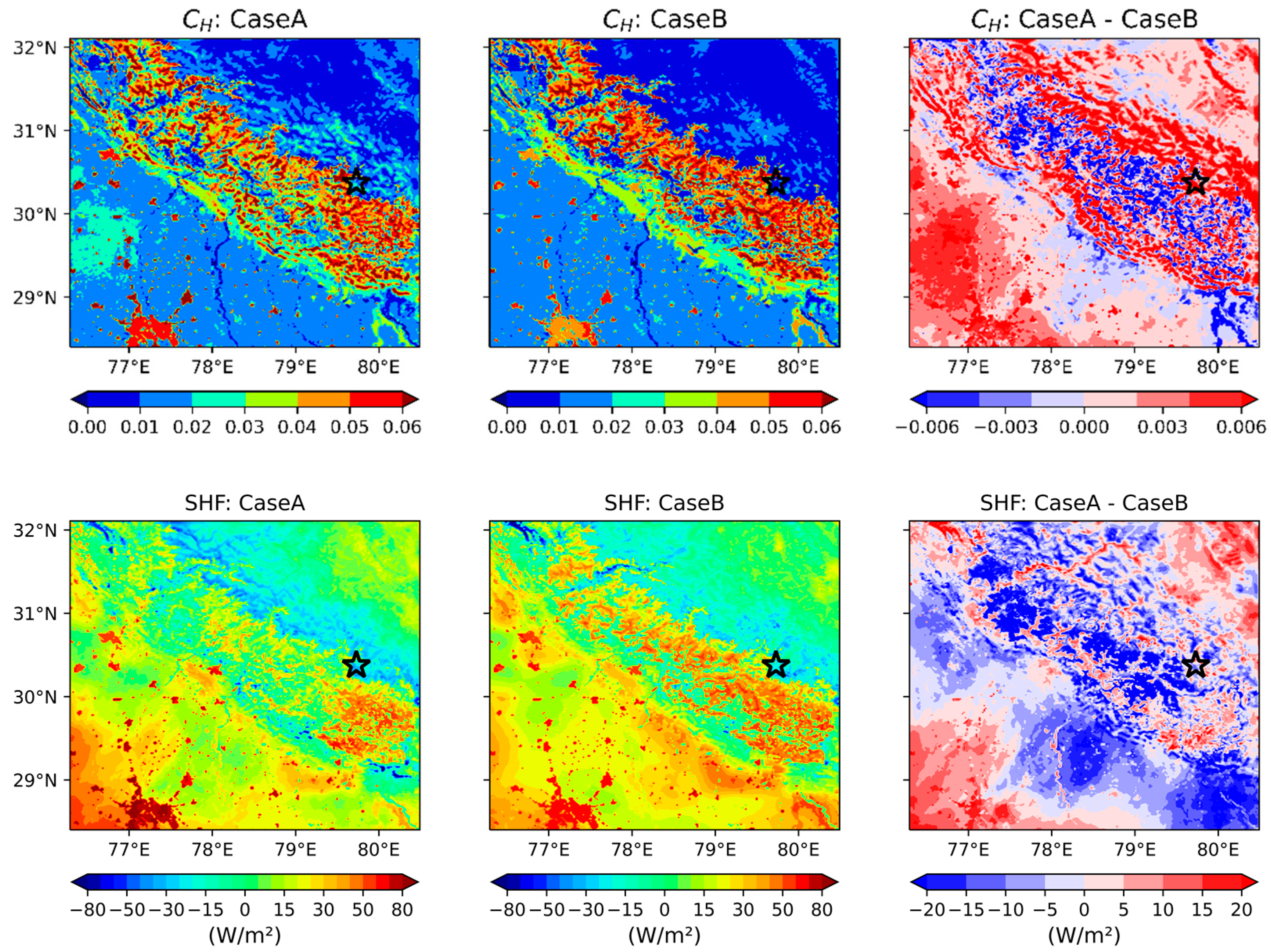

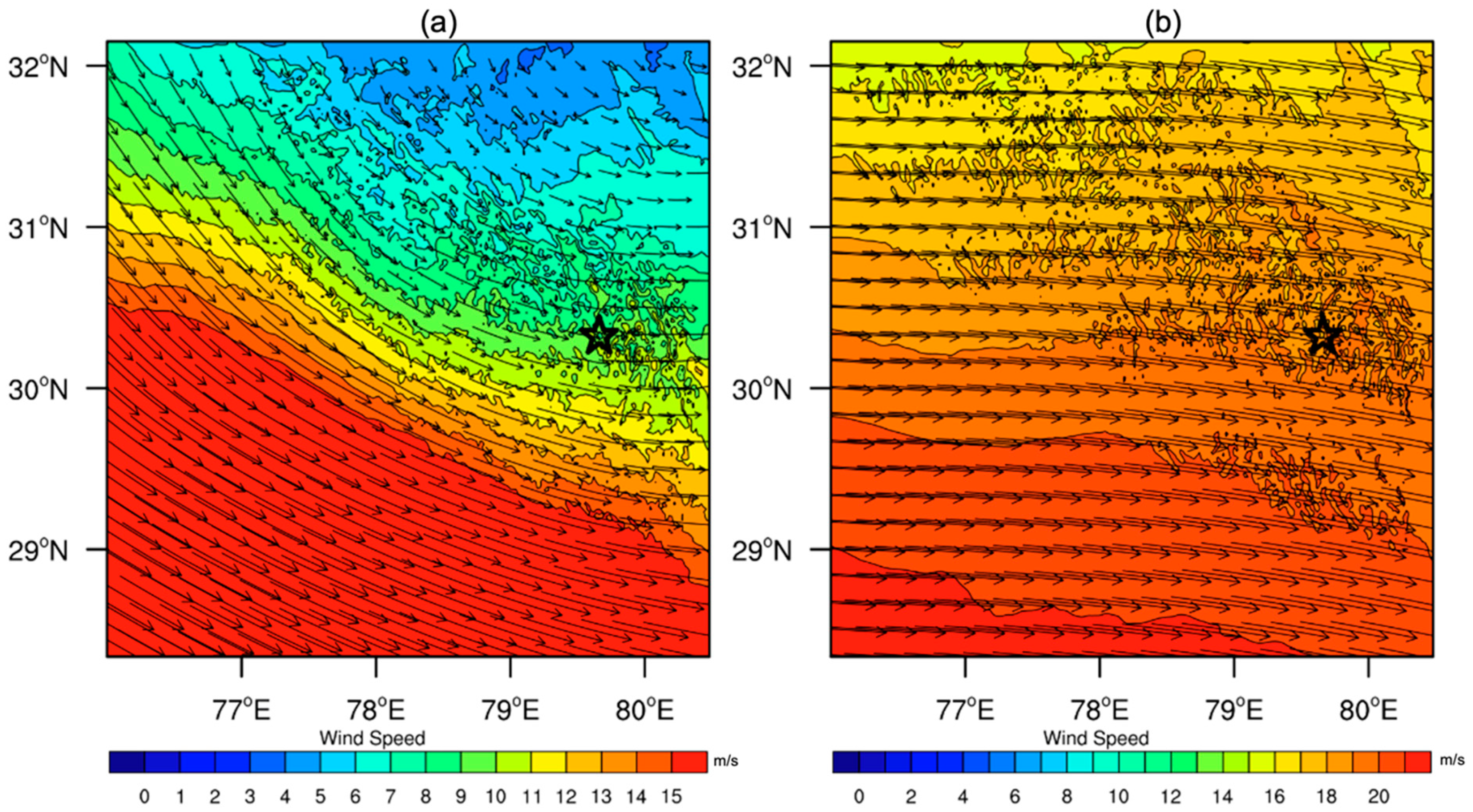
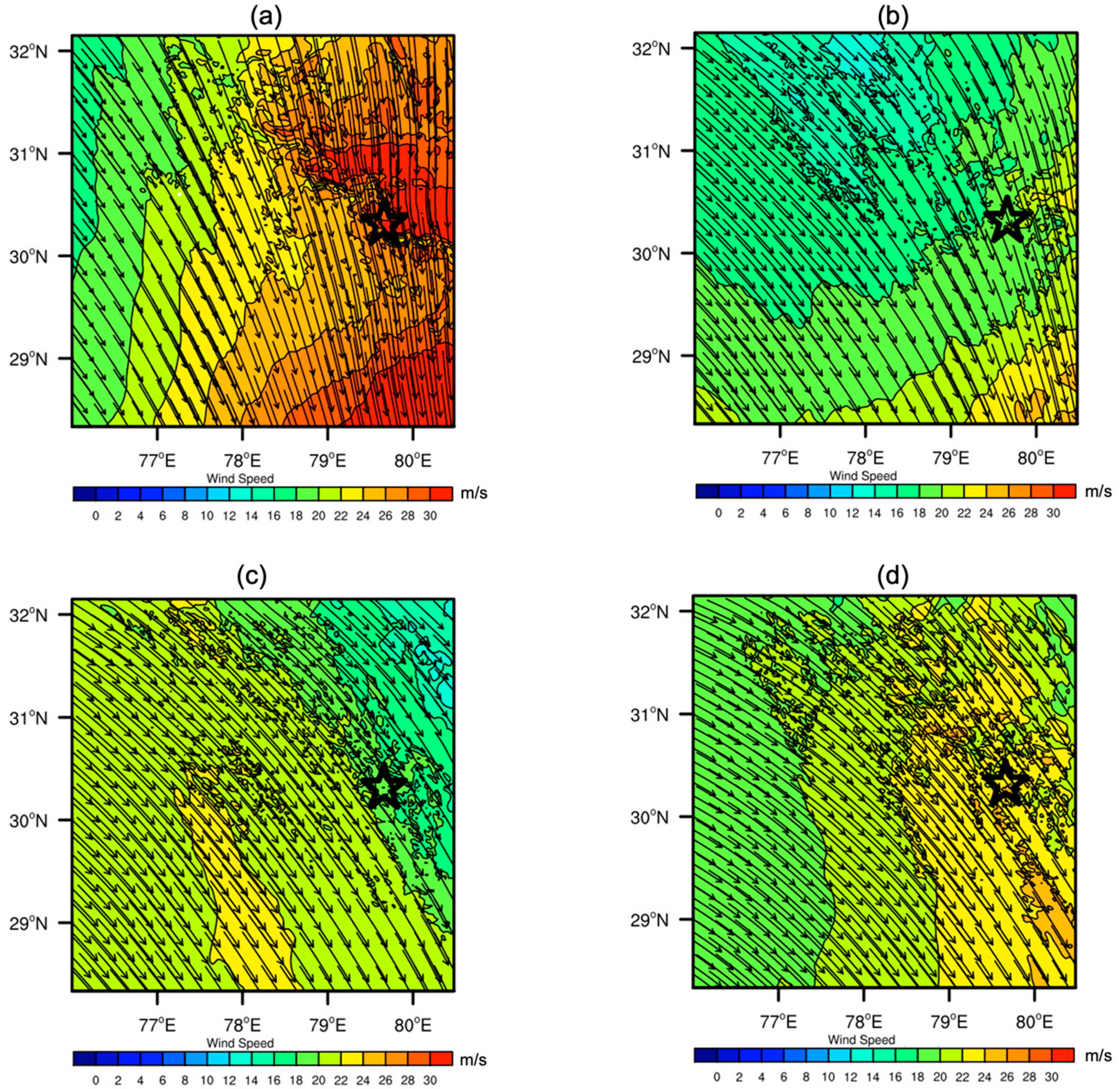
| Statistical Parameter | Chamoli T2m (Ts) | Patiala T2m | Chandigarh T2m | Delhi T2m |
|---|---|---|---|---|
| Mean absolute bias (MAB) | 2.31 (4.83) | 2.21 | 2.17 | 2.31 |
| Root mean square error (RMSE) | 1.87 (3.93) | 1.75 | 1.88 | 1.77 |
| Correlation coefficient (CC) | 0.86 (0.82) | 0.95 | 0.96 | 0.94 |
Publisher’s Note: MDPI stays neutral with regard to jurisdictional claims in published maps and institutional affiliations. |
© 2022 by the authors. Licensee MDPI, Basel, Switzerland. This article is an open access article distributed under the terms and conditions of the Creative Commons Attribution (CC BY) license (https://creativecommons.org/licenses/by/4.0/).
Share and Cite
Srivastava, P.; Namdev, P.; Singh, P.K. 7 February Chamoli (Uttarakhand, India) Rock-Ice Avalanche Disaster: Model-Simulated Prevailing Meteorological Conditions. Atmosphere 2022, 13, 267. https://doi.org/10.3390/atmos13020267
Srivastava P, Namdev P, Singh PK. 7 February Chamoli (Uttarakhand, India) Rock-Ice Avalanche Disaster: Model-Simulated Prevailing Meteorological Conditions. Atmosphere. 2022; 13(2):267. https://doi.org/10.3390/atmos13020267
Chicago/Turabian StyleSrivastava, Piyush, Prabhakar Namdev, and Praveen Kumar Singh. 2022. "7 February Chamoli (Uttarakhand, India) Rock-Ice Avalanche Disaster: Model-Simulated Prevailing Meteorological Conditions" Atmosphere 13, no. 2: 267. https://doi.org/10.3390/atmos13020267







